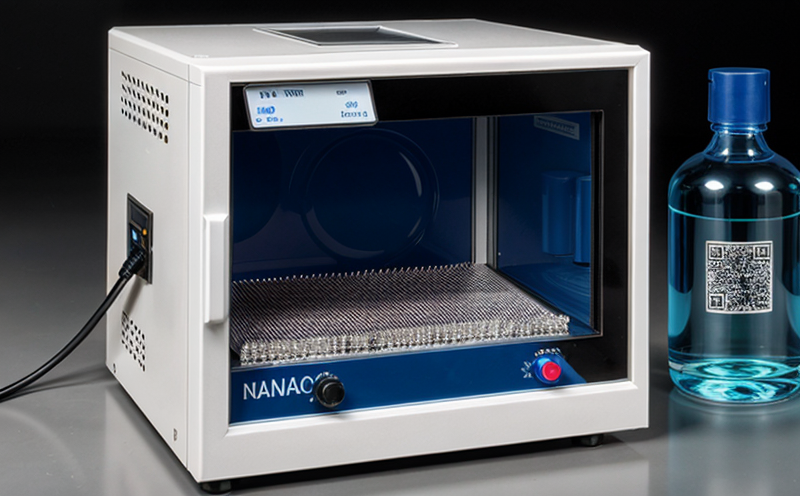Nanochemical Analysis
The field of nanochemical analysis is a critical component in understanding and characterizing nanomaterials. Nanochemical analysis involves detailed examination at the nanoscale, providing insights into chemical composition, structure, and interactions that are not visible through conventional analytical methods.
With the increasing use of nanomaterials across various sectors including pharmaceuticals, electronics, and environmental science, there is a growing need for precise and reliable nanochemical analysis. This service ensures compliance with international standards such as ISO 14644-1 (classification of cleanrooms), ASTM E595 (test methods for characterizing nanomaterials), and EN ISO 28307:2013 (nanoparticle characterization).
The analysis typically involves multiple steps, starting with sample preparation to ensure that the material is in its purest form. This includes dispersing nanoparticles into a solvent or matrix suitable for further testing. Various analytical techniques are then employed, such as Transmission Electron Microscopy (TEM), Scanning Electron Microscopy (SEM), and X-ray Photoelectron Spectroscopy (XPS), each offering unique insights into the sample.
The results of these analyses provide detailed information about particle size distribution, shape, elemental composition, and surface chemistry. These data are essential for quality control in manufacturing processes, ensuring that products meet regulatory requirements and perform as expected.
In addition to providing technical expertise, our laboratory offers comprehensive reports tailored to the specific needs of clients. These reports include all relevant data from each analytical step, along with interpretations and recommendations based on international standards. This ensures a thorough understanding of the material's properties and any potential risks associated with its use.
The precision and reliability of nanochemical analysis are paramount in ensuring product quality and safety. By leveraging advanced instrumentation and experienced personnel, our laboratory can deliver accurate results that meet both industry and regulatory expectations. Our commitment to excellence extends beyond mere compliance; we strive to provide valuable insights that drive innovation and sustainability within each project.
International Acceptance and Recognition
The international recognition of nanochemical analysis underscores its importance in various global industries. Standards such as ISO 14644-1 for cleanroom classification, ASTM E595 for nanomaterial characterization, and EN ISO 28307:2013 for nanoparticle characterization have gained widespread acceptance.
Countries around the world are increasingly adopting these standards to ensure consistent quality in nanotechnology applications. For instance, ISO 14644-1 provides guidelines for maintaining cleanroom environments suitable for handling sensitive materials like nanoparticles. ASTM E595 offers methods for identifying and quantifying different types of nanomaterials, which is crucial for regulatory compliance.
EN ISO 28307:2013 focuses on the characterization of nanoparticles, ensuring accurate measurement of their size and distribution. These international standards not only promote uniformity in testing but also enhance confidence among stakeholders by providing a common language and methodology.
The acceptance of these standards is further bolstered by their endorsement from reputable organizations such as the International Organization for Standardization (ISO), American Society for Testing and Materials (ASTM), and European Committee for Standardization (CEN). This broad backing ensures that nanochemical analysis remains at the forefront of scientific and industrial advancements.
By adhering to these internationally recognized standards, our laboratory contributes significantly to maintaining high ethical standards in nanotechnology research and development. Our commitment to upholding these benchmarks reflects our dedication to delivering accurate, reliable results that are universally accepted across diverse sectors.
Environmental and Sustainability Contributions
The environmental impact of nanomaterials is a growing concern due to their unique properties and potential for widespread use. Nanochemical analysis plays an essential role in assessing these impacts, ensuring that nanotechnology contributes positively to sustainability efforts.
Through meticulous testing and characterization, our laboratory helps identify any adverse effects that nanomaterials might have on the environment. This includes evaluating how nanoparticles behave in different environmental conditions and determining their persistence and bioaccumulation potential.
Incorporating nanochemical analysis into sustainable practices ensures that new technologies are developed responsibly. By understanding the lifecycle of nanomaterials, we can design products that minimize waste and promote recycling. Additionally, this knowledge aids in developing safer alternatives where necessary.
The results from our laboratory help industries adopt more environmentally friendly approaches by providing data on the environmental fate and effects of nanochemical substances. This information supports decision-making processes aimed at reducing harm to ecosystems and human health.
Our dedication to sustainability extends beyond individual projects; it encompasses ongoing efforts to improve methods for analyzing nanomaterials sustainably. By staying ahead of emerging trends in research and development, we contribute to setting new benchmarks that drive positive change within the industry.
Use Cases and Application Examples
| Industry Sector | Application Example |
|---|---|
| Pharmaceuticals | Characterizing drug delivery systems to ensure efficient release of active ingredients. |
| Electronics | Evaluating the stability and performance of electronic components containing nanomaterials. |
| Environmental Science | Assessing the impact of nanochemical pollutants on water quality and soil health. |
| Industry Sector | Application Example |
|---|---|
| Bioengineering | Analyzing biosensors for medical diagnostics to ensure accuracy and reliability. |
| Multimedia | Testing the durability of photovoltaic cells in solar technology applications. |
| Aerospace | Evaluating the mechanical properties of nanocomposites used in aircraft structures. |





